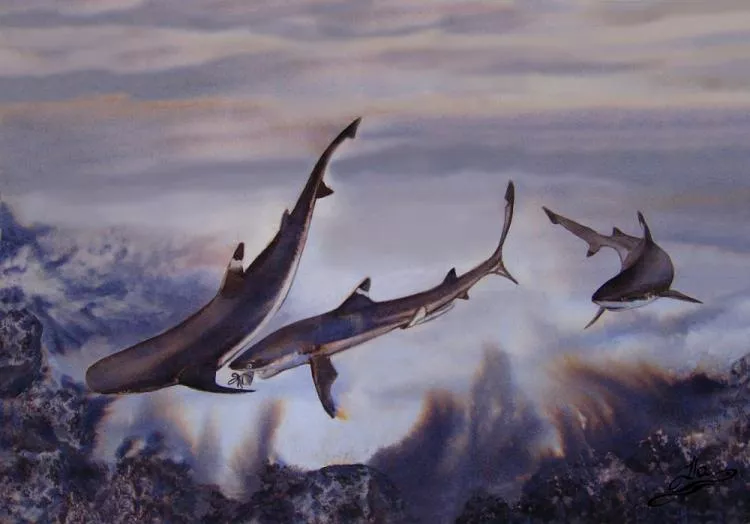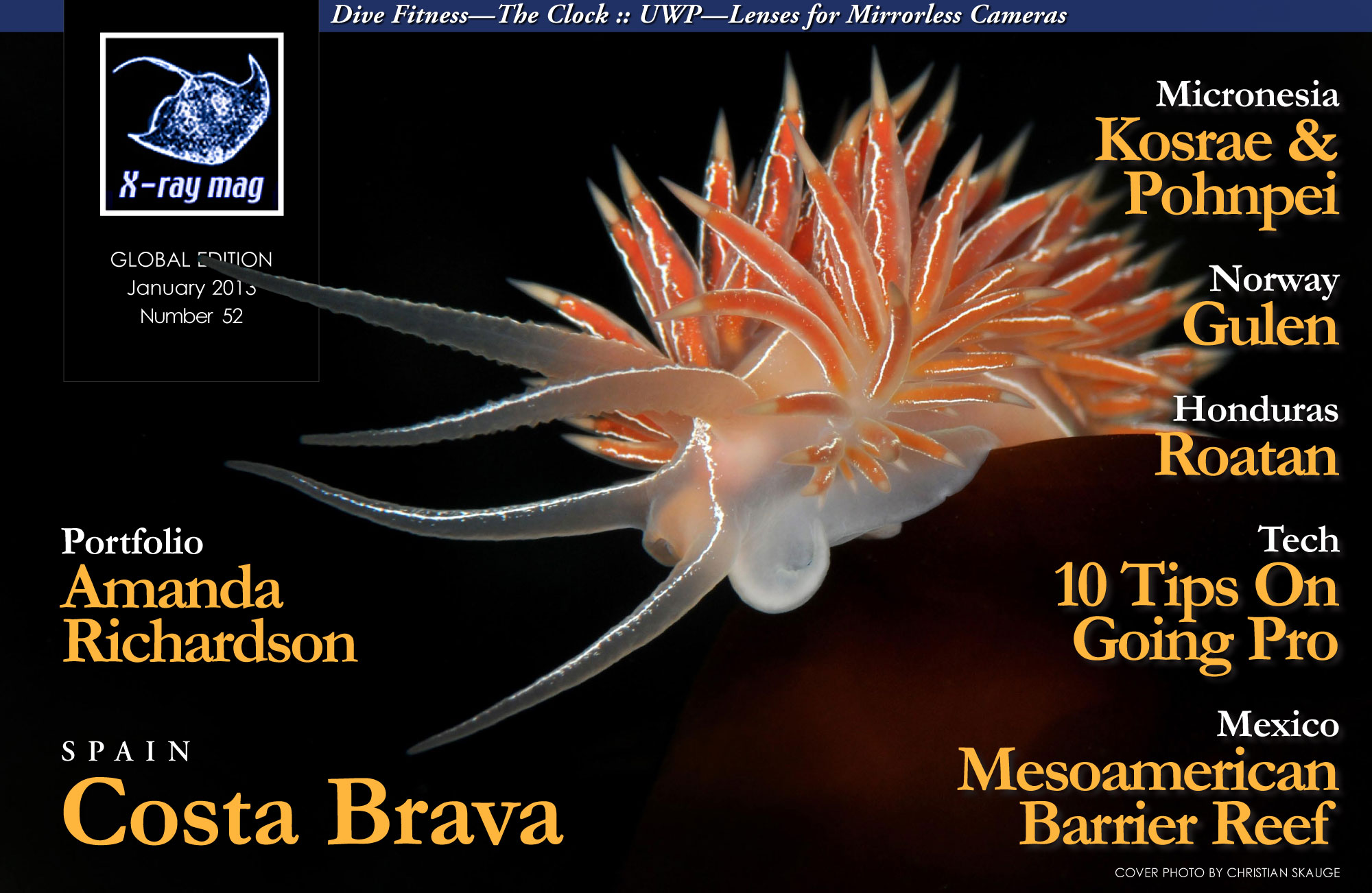Anyone who has faced an agitated shark has felt the power of communication through body language. The response is so immediate and so physical, that emotion, expressing through body language, is revealed as an important medium of pre-vocal communication among animals.
Contributed by
I had some curious experiences with blackfin reef sharks (Carcharhinus melanopterus) while observing them in Tahiti’s lagoons, where they were easy to watch in two meters of water, and sneaked for years through the lagoons and depths off the island to learn what they do when no one is looking. Finally, I conducted a seven-year ethological study. Of all of the startling things that happened, one of the strangest began to unfold after three years had passed.
Shark encounters
The resident sharks had always met my kayak, and when I slid underwater, three of the females—Martha, Madonna and Bratworst—would glide up to my face one after another, turning away just before touching me.
Then one evening, they all did it! Underwater, I found the entire community of three dozen sharks converging on me at high speed and was instantly in a mass of flying torpedoes that whipped around my body. To distract them, I finned hard to push some fish scraps out of the kayak and felt my instep slam one of them with all of my force.
Expecting her to turn and slash, I peered underwater to scrutinize the situation. Martha was curving down to the food, showing no reaction to having been kicked. She had glided between my legs, as I finned upward. Carrellina shot up to my face and away again, and I pushed in the rest of their scraps.
Yet, in spite of the initial excite-ment, the sharks only picked and circled through the area, departing as night fell. No others came to the food left lying on the sand.
Carrellina was an exceptionally bold shark who visited annually from December to April—she had just rejoined us. It was her influence, along with the heightening excitement of the breeding season, that seemed to have triggered the unprecedented rush by the sharks.
A week later, they shot up to me again in high excitement when I appeared underwater. They fed, then began darting up to my face, and going to the boat to sniff it. Holes in the well of the hollow craft where their food was kept were plugged on the way out, but when the scraps went overboard the plugs loosened, so if I held any back, they could smell it.
As night fell, the sharks patrolled watchfully instead of leaving and often rose behind the kayak to sniff it.
The seed of change had been planted when one of them had fallen ill. I had waited each evening in a whirl of sharks with the sick one’s medication hidden in a chunk of food. Though the others had had their weekly feeding session, they began to behave, with increasing conviction, as if they thought I had food I was not giving them—as if I was being tricky.
Finding patterns
I had wanted to find out what they were like, not only as animals, but as individuals. Yet, until I had begun the weekly feeding sessions, I had remained the suspicious alien in their world.
This gesture of benevolence had gained their trust and allowed me to see what I had been unable to observe before—what they were doing when no one was watching. Because around me they began to behave as if no one was watching!
Yet, never had a pattern been established in which they had a regular meal at my weekly sessions. They often missed sessions or came too late to eat, and sometimes the scraps, which contained little real nourishment, were not even eaten. By the time of this story, I had identified most of the sharks who used the lagoon, and could recognize 300 individuals on sight.
Weeks passed while I watched the sharks’ evolving behaviour with puzzlement. Infrequent visitors joined the resident sharks in swarming up to me, and then made repeated charges by themselves. Fast charges by the shy older female visitors were unprecedented. Carrellina was joined in her bad behaviour by several females who, like her, were in their first year of reproduction—I began thinking of them as “the juvenile delinquents”.
Then one night, the sharks’ relentless circling reached new heights of tension. They repeatedly charged while Carrellina orbited my head, and her buddy Chevron passed me again and again. I dared not move a muscle for fear of triggering a mass charge, and faced each shark, scarcely breathing, as she swam up to my face. Finally, when they circled away, I flew to the kayak, leaped in and tossed in the tuna heads I had brought for the nurse sharks. The lagoon boiled, as the sharks pounced in darkened waters that obscured the wild melee beneath.
Just three days later, I was unexpectedly given some fish scraps and returned, accompanied by a young seabird I had rescued. Carrellina and her gang undulated around the boat, as I prepared. The bird alighted on the shark-food, stared down at the sharks and flew. She glided low over the surface, and the sea actually quivered, as the fish startled. So I failed to see how it happened, that just at that moment, the sharks attacked the boat!
The heavy weight of the loaded kayak with me on it was bashed with shocking force first one way and then the other, as they slammed it from multiple directions. Somehow, they had acted in synchrony. The surface was solid with sharks emerging at high speed, twisting and bashing the kayak, while more replaced those shooting away. Then, they leaped out of the water to snatch at the food behind me. All around me in the air, their jaws were loudly snapping shut, and one got a good bite of a scrap that overhung the water.
The heavy blows came mostly from beneath, and it was hard to turn in the narrow craft to see behind me, where the sharks surged out to snatch at the scraps. Carrellina passed repeatedly at high speed. She had been the instigator, and among those I was able to identify were the juvenile delinquents.
Instead of sliding in, I began throwing the food to them, hoping they would calm down and feed. But even after I finished, Chevron shot up to slam the kayak over and over again.
When she went into search mode, I slid underwater. Golden sunlight flickered over the coral, and the graceful sharks soaring through. Each snatched up a scrap and accelerated to shake out a bite, while the falling piece was caught up by one in pursuit. Several visitors were among them, adding to the excitement, and none paid attention to me, as I drifted, writing down their names.
Shark rage
Their attack confirmed that I had been right about their subjective state when they had circled me so tensely three days before. The way Chevron had repeatedly torpedoed the kayak after I had fed them suggested that she was finally venting intense feelings of shark-anger or rage. The desire for food was not the motivation for slamming the kayak; it was their anger toward me.
At home I found that some of the kayak’s straps had been cut, punctured and sliced by their sharp little teeth.
I went with dread to the next shark session. There was a slight bump, as I prepared, then silence. But before I could feed them, Carrellina slammed the kayak hard, and the rest joined in.
They began to leap out of the sea while I twisted in the narrow craft to grasp the slippery scraps from behind me, and throw them. Watching and listening to their jaws snapping shut with loud clapping sounds, it was obvious that in a kayak, it was not easy to keep all of one’s body out of the edible zones. I had thrown in quite a bit of food when Martha suddenly broke through the surface beside my right elbow and snapped her jaws closed on a trailing scrap.
The power of the movement was shocking. She had come so close to catching my arm in her teeth.
For the very first time, I didn’t want to get into the water, roiling with blood and sharks. But eventually I slid in. The same sharks I had known for so long were whirling, feeding in the site, and I began to wonder whether their actions were due more to impatience to get the food by themselves, than rage this time.
Indeed, I theorized, they were like excited children helping themselves to birthday cake without waiting to be served. Once their spontaneous attack had begun on the boat, they had found that their food was right there, so on the next leap, they targeted it. Could this latest incident be the confirmation of a new foraging method? The species normally does not breach, look above the surface, nor feed above the surface, so their behaviour was all the more remarkable, and actually reminiscent of a cultural development!
New foraging methods
To be sure, I verified that the behaviour of the sharks attending the commercial shark feeding dives had not changed—only among my sharks had the change in behaviour occurred.
By the next session I had decided that they would no longer be rewarded for their bad behaviour with food raining down. Instead, I would photograph their new foraging behaviour and time it.
When they stopped their bashing and leaping, I would feed them.
But no sharks met me, and underwater I found a peaceful gathering of mostly juveniles and males. As night fell, I was floating a treat to Martha when Madonna zoomed around a coral, and ...
(...)
























